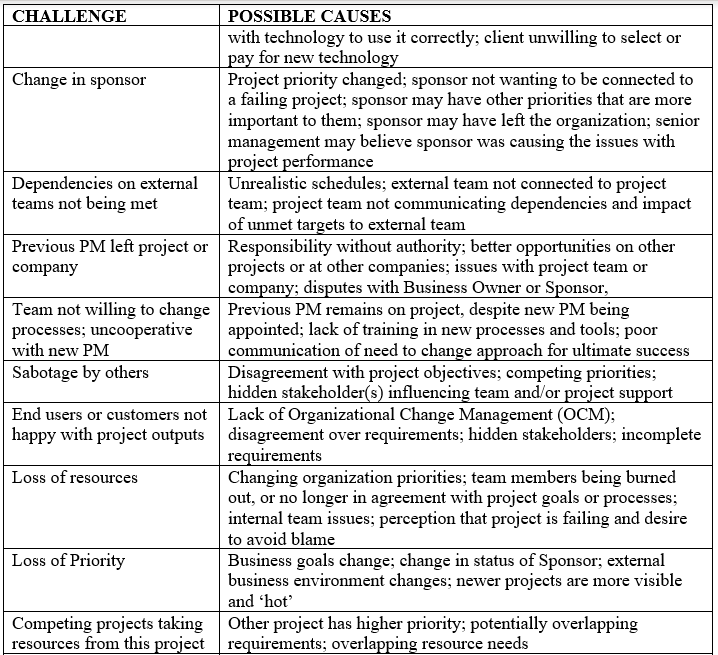
Potential Challenges With Ongoing Projects
When joining a project that has already started or when tasked to review an existing project, a Project Manager is faced with a number of challenges. These primarily relate to not having been with the project team from the beginning and, therefore, not having been part of the planning process. As noted in a prior article, scope, schedule, and budget are probably already set. Many other decisions have also been made, some explicit, some implicit. This leads to the first challenge that the new PM has—what is the true status of the project? We’ll describe how to determine the true status of the project in more detail in a future article, along with providing some useful tools. Before going there, we should look at potential challenges that arise because a change in PM is contemplated or occurring. These challenges or issues will be added to those that already exist in the project and will also need to be addressed as part of the takeover and recovery plan.
There are many reasons for another PM taking over a project, and the project itself may not be in trouble; it may truly be in “Green” status. While that is great and makes things easier for the incoming PM, there are still challenges tied to the change in management that must be dealt with. Let’s review a few of these.
First, the previous PM may no longer be available. They may have left the organization, be out on extended personal leave, been moved to a different project, and not available for a hand-off, etc. This means the incoming PM is unlikely to have access to all the information that the previous PM had, especially around the reasons why certain decisions were made. For example, why was the delivery broken into three increments? Why are there four Scrum Teams instead of three? While interviewing the Business Owner (BO), Sponsor, Customer, and delivery team should provide some insights, if we can’t talk to the previous PM directly, we are unlikely to know why they made the decisions that they did.
Second, at the opposite end of the spectrum, the former PM may still be around, perhaps due to subject matter or technical expertise. Since they are still part of the delivery team, there are likely to be team and political issues with them no longer being in charge. The incoming PM needs to understand the reasons for the change and the decision to keep the former PM on the team. Specific actions will be needed to reduce any team or political fallout from the change and to ensure that the team continues to move forward as a team.
Advertisement
[widget id=”custom_html-68″]
Another challenge can arise if the Sponsor, Business Owner, or Customer change at the same time as the PM. Or if one is assessing a project due to a Business Owner change and a project review is requested. There have been cases where a successful Business Owner and PM that work well together are moved to higher priority programs or projects, especially if the current project is going well. This adds to the existing incoming PM challenge of building a relationship with the new Business Owner and rebuilding the team dynamic. Many Business Owners joining a project want to review prior decisions, change requirements and agreements, and potentially alter the goals of the project, all to mold the project to meet their goals and add their personal stamp onto the project. While this is a natural human reaction, it can be deadly in a project. The incoming PM needs to hold the line and minimize the disruption to the project, often without a full understanding of the rationale behind decisions already made. This is difficult to do, even while promising to look further into issues raised by the Business Owner. Diplomacy and firmness are both needed to avoid unnecessarily impacting the project.
Of course, there can be non-political challenges as well. When Project Managers discuss situations that they have found when assuming leadership of a project, it is striking how different they are from starting a new project. One of the key differences is that the ongoing project may already show evidence of problems, or have challenges. We’ve listed some common project challenges and possible causes in the table below. The challenges identified when a new PM is being asked to take over a project will influence the initial steps in assuming command, and should be discussed with management as part of accepting the new assignment. We’ll cover how to handle this in upcoming articles.



As you can see in the table, many challenges (symptoms) can result from similar causes and be related to multiple issues. It is important to avoid jumping to conclusions or developing action plans before getting to the real causes of the challenges. Future articles will describe the how to get to the root causes and ways to address them. In the meantime, how would you assess the true status of a project that you are joining?
For more information on how to handle this situation, and a guide for taking over an in-flight project, please check out my book on the topic. There’s a New Sheriff in Town: The Project Manager’s Proven Guide to Taking Over Ongoing Projects and Getting the Work Done. https://www.amazon.com/Theres-New-Sheriff-Town-Successfully/dp/B0BMJ4J7GL